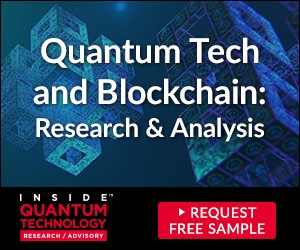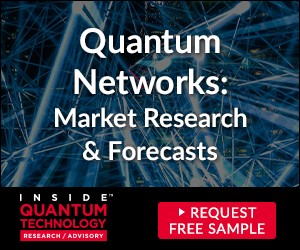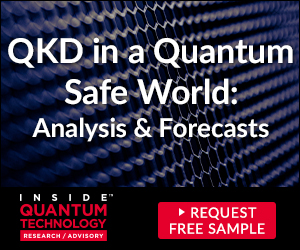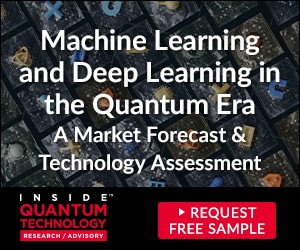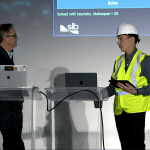Quantum News Briefs May 30: Quantum computing can help secure the future of AI systems; NaaS vendors on front line to deliver quantum-ready security; Shenzhou-16 astronauts arrive at China’s space station; mission includes experiments on quantum phenomena + MORE

Quantum News Briefs May 30: Quantum computing can help secure the future of AI systems; NaaS vendors on front line to deliver quantum-ready security; Shenzhou-16 astronauts arrive at China’s space station; mission includes experiments on quantum phenomena + MORE.
Quantum computing can help secure the future of AI systems
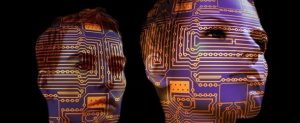 Muhammad Usman and colleagues at University of Melbourne recently proposed that the integration of quantum computing in machine learning models could yield new algorithms with strong resilience against adversarial attacks. Usman discussed the research in the May 26 EconoTimes; Quantum News Briefs summarizes.
Muhammad Usman and colleagues at University of Melbourne recently proposed that the integration of quantum computing in machine learning models could yield new algorithms with strong resilience against adversarial attacks. Usman discussed the research in the May 26 EconoTimes; Quantum News Briefs summarizes.
Many systems that require strong security are either already underpinned by machine learning or soon will be. These systems include facial recognition, banking, military targeting applications, and robots and autonomous vehicles. Machine learning algorithms are highly vulnerable to data manipulation attacks, which can pose serious security risks. Manipulated data can also be injected during the testing phase (after training is complete),
The consequences of data manipulation attacks can be severe. For example, if a self-driving car uses a machine learning algorithm that has been compromised, it may incorrectly predict there are no humans on the road – when there are. On the front lines, troops might wear uniforms that can fool AI-based drones into identifying them as landscape features.
we describe how integrating quantum computing with machine learning could give rise to secure algorithms called quantum machine learning models.
Usman and colleagues have carefully designed algorithms to exploit special quantum properties that would allow them to find specific patterns in image data that aren’t easily manipulated. The result would be resilient algorithms that are safe against even powerful attacks. They also wouldn’t require the expensive “adversarial training” currently used to teach algorithms how to resist such attacks.
Beyond this, quantum machine learning could allow for faster algorithmic training and more accuracy in learning features.
On one hand, quantum machine learning models will provide critical security for many sensitive applications. On the other, quantum computers could be used to generate powerful adversarial attacks, capable of easily deceiving even state-of-the-art conventional machine learning models.
Moving forward, we’ll need to seriously consider the best ways to protect our systems; an adversary with access to early quantum computers would pose a significant security threat. Click here to read EconoTimes article in-entirety.
NaaS vendors on front line to deliver quantum-ready security
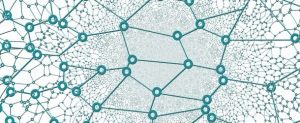 Many CIOs are moving from managing their own network to buying connectivity, managed Wi-Fi, capacity and even security and access control from expert service providers that offer networking as a service (NaaS). They are effectively outsourcing the building, maintenance, upgrading and operating of the network to a trusted and experienced service provider. Vince Berk, the Chief Strategist at Quantum Xchange, a post-quantum crypto-agility provider discusses the challenges these CIO face as the era of quantum computing approaches. Quantum News Briefs summarizes Berk’s May 25 article.
Many CIOs are moving from managing their own network to buying connectivity, managed Wi-Fi, capacity and even security and access control from expert service providers that offer networking as a service (NaaS). They are effectively outsourcing the building, maintenance, upgrading and operating of the network to a trusted and experienced service provider. Vince Berk, the Chief Strategist at Quantum Xchange, a post-quantum crypto-agility provider discusses the challenges these CIO face as the era of quantum computing approaches. Quantum News Briefs summarizes Berk’s May 25 article.
As every organization is unique, these providers are differentiating themselves in how well they can create a customized offering to suit each specific need. For instance, connecting an electric utility grid with many small sites requires a different network than connecting a factory manufacturing facility to backend headquarters and data centers.
just as connectivity requirements differ from business to business, so do security requirements. Hospitals, for example, must comply with HIPAA standards designed to protect sensitive patient data. This introduces a different and nuanced set of requirements for their security.
Yet there’s one area of network security that NaaS providers may be overlooking: cryptographic agility, also referred to as crypto-agility.
The U.S. government is pushing ahead with plans to develop a new, quantum-resistant cryptographic standard, based on new mathematical algorithms. Yet as soon as quantum computers hit their stride, even a new standard is at risk of being broken far more quickly than anyone wants to believe. Further encryption evolution is necessary and expected.
The opportunity for NaaS vendors is to deploy crypto agility now as part of a strategic plan to establish a future-proof infrastructure that can easily keep pace with changing business requirements, regulatory mandates and customer demands well into the era of quantum computing. Click here to read Berk’s complete article in Forbes.
Shenzhou-16 astronauts arrive at China’s space station; mission includes experiments on quantum phenomena
A crew of three astronauts including the first Chinese civilian astronaut has arrived at the Tiangong space station, according to May 30 SpaceNews.
A Long March 2F rocket carrying the Shenzhou-16 spacecraft lifted off from the Jiuquan Satellite Launch Center in the Gobi Desert at 9:31 p.m. Eastern May 29. Rendezvous and docking with a radial Tiangong docking port was completed at 4:29 a.m. May 30, China’s human spaceflight agency.
The Shenzhou-16 astronauts will conduct a range of on-orbit tests and experiments in various fields, including quantum phenomena, high-precision space time-frequency systems, the verification of general relativity, and the origins of life.
The mission has been hailed as one of major significance for China. “China’s space station has entered the application and development stage. Our ability today to produce Shenzhou spacecraft is no longer the same as before,” He Yu, chief commander of crewed spaceship systems at the China Academy of Space Technology (CAST), told CCTV. Click here to read SpaceNews article in-entirety.
JPMorgan Chase & QC Ware collaborate on quantum finance for deep hedging

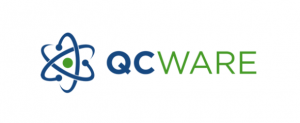
JPMorgan Chase has a long history of continually advancing its trading technology. In 2018, a team of diverse researchers, from JCMorgan Chase developed a stochastic model on Deep Hedging.
Earlier this year, JPMorgan Chase, QC Ware and the University of Paris successfully developed and used deep reinforcement learning algorithms and quantum computing to improve on the 2019 deep hedging model. The team also designed two additional and important algorithms that contributed to the success of the project: a policy search algorithm and an actor-critic algorithm. Quantum News Briefs summarizes a May 22 Forbes article Paul Smith-Goodson, Moor Insights and Strategy,discussing this effort
This project was the first collaboration between JPMorgan Chase and QC Ware. Smith-Goodson discusses how it was developed with two key members of the research team.
“We are very happy with the results,” Dr. Pistoia said. “Of course, we cannot use this algorithm in today’s production environment because the hardware is not yet up to speed. However, the essence of our work is to become quantum ready. So we build the algorithms and then when the hardware catches up, we have the algorithms ready. And, we’re also happy because in this case we have a higher-quality solution.”
He also spoke with Dr. Iordanis Kerenidis is the senior vice president of quantum algorithms at QC Ware Corp. research director at the Centre national de la recherche scientifique (CNRS) and director at the Paris Centre for Quantum Computing. Dr. Kerenidis said, “What we found out from this research is that quantum is actually natively very good in a distributional approach because quantum states can naturally hold large distributions,” he said. “This was the right framework to use, and because it’s so natively quantum, quantum reinforcement learning, and in particular the distributional actor-critic algorithm, is very effective and produces very good results.”
This research was done on Quantinuum’s H1-1 and H1-2 trapped-ion quantum processors, utilizing circuits with up to 16 qubits.
Development of this quantum deep hedging algorithm is important research for several reasons:
A. The researchers replaced a classical bottleneck in the original 2019 algorithm with a quantum solution but left the basic logic of the original algorithm intact.
B. This research represents a turning point because the algorithm demonstrates quantum computing’s deep learning capabilities, not only in finance, but in the general area of machine learning.
C. The researchers cleverly used superposition to analyze all possible future values simultaneously. This cannot be done classically because the problem is exponentially complex. An attempt to solve it classically would limit the solution to suboptimal approximations.
D. Overall, the research team met objectives for developing the quantum deep hedging model.
Click her to read this substantive, lengthy article in-entirety.
Sandra K. Helsel, Ph.D. has been researching and reporting on frontier technologies since 1990. She has her Ph.D. from the University of Arizona.













